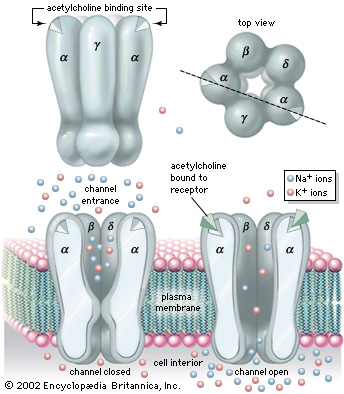Sandbox Reserved 475
From Proteopedia
| Line 3: | Line 3: | ||
<!-- PLEASE ADD YOUR CONTENT BELOW HERE --> | <!-- PLEASE ADD YOUR CONTENT BELOW HERE --> | ||
| - | = <span style="font-size:120%">ACETYLCHOLINE RECEPTOR</span> = | + | == <span style="font-size:120%">'''ACETYLCHOLINE RECEPTOR'''</span> == |
<Structure load='2bg9' size='400' frame='true' align='right' | <Structure load='2bg9' size='400' frame='true' align='right' | ||
caption='Refined nicotinic receptor structure at 4.0 Å resolution ([[2BG9]]). 5 chain structure of Ion channels with sequence from [http://en.wikipedia.org/wiki/Marbled_electric_ray Torpedo marmorata].' scene='' /> | caption='Refined nicotinic receptor structure at 4.0 Å resolution ([[2BG9]]). 5 chain structure of Ion channels with sequence from [http://en.wikipedia.org/wiki/Marbled_electric_ray Torpedo marmorata].' scene='' /> | ||
| Line 12: | Line 12: | ||
<span style="font-size:110%">Acetylcholine receptor proteins are present in the peripheral nervous system (PNS) as well as the central nervous system (CNS) in humans and many organisms, including invertebrates. The function of the receptor follows a general mechanism to which it is applied to almost any organism with a nervous system, that relies on the firing action potentials of the neurons. </span> | <span style="font-size:110%">Acetylcholine receptor proteins are present in the peripheral nervous system (PNS) as well as the central nervous system (CNS) in humans and many organisms, including invertebrates. The function of the receptor follows a general mechanism to which it is applied to almost any organism with a nervous system, that relies on the firing action potentials of the neurons. </span> | ||
| - | == Mechanism == | + | == '''Mechanism''' == |
| - | == Structure == | + | == '''Structure''' == |
| - | == Medical Applications == | + | [[Image:Nicotinic Acetylcholine Receptor.jpg |left|alt=text|Caption]] |
| - | == References == | + | In vertebrates, nicotinic receptors are classified by their main sites of expression into two subtypes: muscle-type nicotinic receptors and neuronal-type nicotinic receptors. In the muscle-type receptors, found at the neuromuscular junction, receptors are either the embryonic form, composed of α1, β1, δ, and γ subunits in a 2:1:1:1 ratio, or the adult form composed of α1, β1, δ, and ε subunits in a 2:1:1:1 ratio.[1][2][3][7] The neuronal subtypes are various combinations of twelve different nicotinic receptor subunits: α2 through α10 and β2 through β4. In both muscle-type and neuronal-type receptors, the subunits are somewhat similar to one another, especially in the hydrophobic regions. |
| + | <span style="font-size:110%"> | ||
| + | |||
| + | </span> | ||
| + | == '''Medical Applications''' == | ||
| + | == '''References''' == | ||
Revision as of 01:01, 1 May 2012
| This Sandbox is Reserved from 13/03/2012, through 01/06/2012 for use in the course "Proteins and Molecular Mechanisms" taught by Robert B. Rose at the North Carolina State University, Raleigh, NC USA. This reservation includes Sandbox Reserved 451 through Sandbox Reserved 500. | |||||||
To get started:
More help: Help:Editing For more help, look at this link: http://www.proteopedia.org/wiki/index.php/Help:Getting_Started_in_Proteopedia
ACETYLCHOLINE RECEPTOR
Nicotinic Acetylcholine Receptor (nAChRs) is a neurotransmitter receptor also known as a specialized integral membrane protein. Integral membrane proteins are permanently bound to the phospholipid bilayer. They provide a communication pathway between the internal and external environments of the cell. Acetylcholine receptor proteins reside as ligand-gated ion channels on the motor end plate of the postsynaptic cleft in the neuromuscular junction. nAChRs as an ionotropic receptor, they are activated by the binding of the acetylcholine neurotransmitter. Once the receptor is activated the ion channel opens allowing the exchange of salt ions. Nicotinic acetylcholine receptors are responsible for the regulation of sodium (Na+) ion concentration entering and potassium (K+) ion concentration leaving the muscular cytosol, ultimately resulting in an action potential from the differences in electrochemical gradients. Acetylcholine receptor proteins are present in the peripheral nervous system (PNS) as well as the central nervous system (CNS) in humans and many organisms, including invertebrates. The function of the receptor follows a general mechanism to which it is applied to almost any organism with a nervous system, that relies on the firing action potentials of the neurons. MechanismStructureIn vertebrates, nicotinic receptors are classified by their main sites of expression into two subtypes: muscle-type nicotinic receptors and neuronal-type nicotinic receptors. In the muscle-type receptors, found at the neuromuscular junction, receptors are either the embryonic form, composed of α1, β1, δ, and γ subunits in a 2:1:1:1 ratio, or the adult form composed of α1, β1, δ, and ε subunits in a 2:1:1:1 ratio.[1][2][3][7] The neuronal subtypes are various combinations of twelve different nicotinic receptor subunits: α2 through α10 and β2 through β4. In both muscle-type and neuronal-type receptors, the subunits are somewhat similar to one another, especially in the hydrophobic regions.
Medical ApplicationsReferences |

